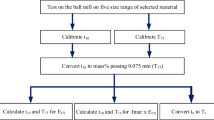Abstract
Mine plans typically consider the profits and costs associated with extracting and processing minerals into marketable products. Interrelationships between mine and mill costs are often overlooked during the process of mine plan optimization. A simple and quick method for predicting milling costs for a given block would improve the planning process, especially if the procedure could be incorporated as part of routine ore grade analysis of drill core or cuttings. Incorporating milling costs as part of the mine planning process could improve overall optimization of the mine/mill combination. A method developed by the Utah Comminution Center(UCC) at the University of Utah provides a possible answer to the need for reasonably quick and reliable grinding cost estimation (King et al., 1996). Using results from single particle impact tests, a work index called the Utah load cell work index (ULCWI) is calculated. The potential for routine use of the new method is explored by comparing ULCWI values with corresponding Bond work index (BWI) values for eight mineral materials (Free, 2000).
Similar content being viewed by others
References
Bond, F.C., 1952, “The third theory of comminution,” Transactions SME-AIME, Vol. 193, pp. 484–494.
Bond, F.C., 1961, “Crushing and Grinding Calculations,” Allis Chalmers Publication 07R923B.
Free, K.S., 2000, “Relationship between Bond Work Index and Single Particle Comminution Parameters,” Masters Thesis, University of Utah.
King, R.P., 2001, Modeling and Simulation of Mineral Processing Systems, Butteworth-Heinemann, Oxford.
King, R.P., Tavares, L.M., and Middlemiss, S., 1996, “Establishing the energy efficiency of a ball mill,” Submission for Publication
Milin, L., 1994, “Incomplete Beta Function Modeling of the t10 Procedure,” Internal report, Comminution Center, University of Utah, pp. 43
Narayanan, S.S., and Whiten, W.J., 1988, “Determination of comminution characteristics from single-particle breakage tests and its application to ball-mill scale-up,” Trans. Instn. Min. Metall., Sec. C, Vol. 97, pp.115–123.
Tavares, L.M., 1997, “Microscale Investigation of Particle Breakage Applied to the Study of Thermal and Mechanical Predamage,” Ph.D. thesis, University of Utah.
Author information
Authors and Affiliations
Additional information
Preprint number 04-091, presented at the SME Annual Meeting, Feb. 23–25, 2004, Denver, Colorado. Discussion of this peer-reviewed and approved paper is invited and must be submitted to SME Publications Dept. prior to Nov. 30, 2005.
Rights and permissions
About this article
Cite this article
Free, K.S., McCarter, M.K. & King, R.P. Evaluation of a new method for work index estimation using single particle impact tests. Mining, Metallurgy & Exploration 22, 96–100 (2005). https://doi.org/10.1007/BF03403121
Accepted:
Published:
Issue Date:
DOI: https://doi.org/10.1007/BF03403121




